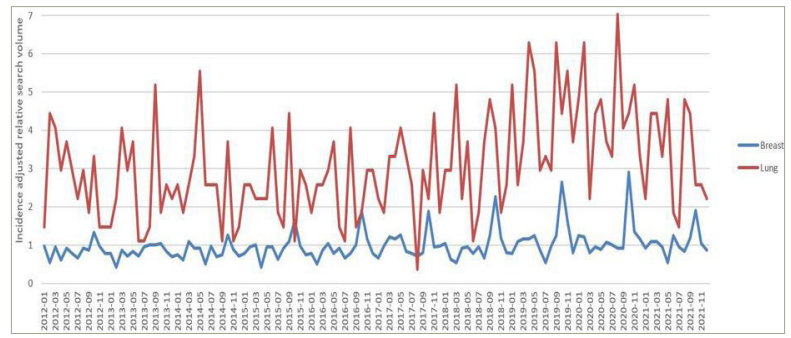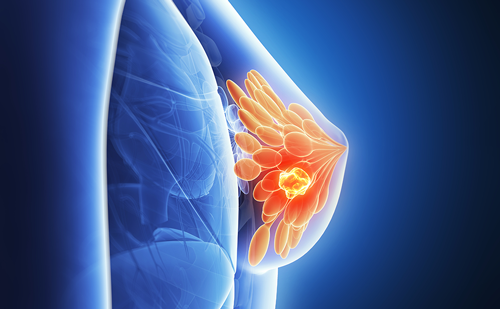The incidence rate of breast cancer (BC) is the highest in Pakistan among all Asian countries.1Expand Reference In 2018 alone, 2.1 million cases were diagnosed, although the exact number is likely much higher due to poor reporting in rural areas and the lack of a formal national cancer registry.1,212 Over the last decade, multiple non-governmental organizations and large cancer care institutions have led mass media campaigns to raise awareness regarding BC to improve screening and early detection.1,3,4134 Web-based surveillance of online search activity is an emerging metric to assess the effectiveness of such endeavours. Recent studies have shown a strong relationship between health campaigns and information-seeking behaviours, suggesting that infoveillance can measure the success of such public health drives.5,656 Our study determines the online public activity related to BC in Pakistan over the last decade. We hypothesize that the data regarding search queries may be correlated with the collective interest of the population in the disease.
On 23 December 2021, we queried Google Trends, a public web facility of Google Inc. based on Google Search, and downloaded the data for the topic ‘lung cancer’ and the disease ‘breast cancer’. We selected a general web search under ‘all categories’ and narrowed the region of interest to include search volume from Pakistan only. Data were collected from December 2011 to December 2021 (120 months). Google Trends provides the results in the form of monthly relative search volume (RSV) ranging from 1 to 100 for each searched term. An RSV value of 100 indicates peak popularity, and a score of 0 indicates that the term is <1% of its peak popularity. Due to the relative nature of the result, we compared the RSV of BC with that of lung cancer (LC) to add a frame of reference.7Expand Reference We chose LC for comparison as it is also another common malignancy in the region but with a much lower incidence rate than BC. To account for the difference in incidence between the two cancers, we adjusted the RSV for incidence by dividing the monthly RSV by incidence rates (34.7 per 100,000 for BC and 2.7 per 100,000 for LC based on 2020 data) to obtain the corresponding incidence-adjusted RSV (Figure 1).8Expand Reference
Independent-samples t-test was performed for statistical analysis. A p value of <0.05 was considered significant. This article is a descriptive analytical study. As the data were publicly available and no individual patient identification data were required it is not subject to Institutional Review Board approval.
Figure 1: The temporal trend of incidence-adjusted relative search volume from December 2011 to December 2021

X axis: Time (year-month).
Data were gathered on 23 December 2021 in New York, USA.
For the entire period, the highest popularity (relative interest scores [RIS]=100) was recorded in October 2020 for BC, likely due to activities related to BC Awareness Month. Similar but smaller surges in RIS were observed in October of the preceding years (RIS=89 in October 2019 and RIS=79 in October 2018). However, when the incidence-adjusted relative interest scores (iRIS) were calculated, the interest in LC was significantly higher compared with BC (Figure 1). Overall, the mean (± standard deviation) for LC and BC was 3.07 ± 1.34 and 0.99 ± 0.38, respectively, with difference of 2.08 (± 95% confidence interval: 1.83–2.33) and p value <0.001.
The results show that online activity to gather health-related information regarding BC remains low despite the recent efforts to garner interest. This is of critical importance as health-related internet searches are now becoming a common practice for the initial understanding of disease pathophysiology before seeking medical consultation.9,10910 An important reason for the lack of online interest in BC among Pakistanis can be due to the inequity of internet access among males and females in the country. In comparison with 40% of the male population, only 11% of Pakistan’s 112 million female population has internet access.11Expand Reference As internet use in Pakistan is disproportionately male-dominated, it is understandable that search activities for diseases predominantly affecting females do not generate large volumes of interest, despite their high prevalence and mortality rates. Moreover, most of the literature available online about the disease is in English, which is not widely understood in rural Pakistan.
In developing nations such as Pakistan, widespread access to and acceptance of age-appropriate regular screening mammograms will likely remain a challenge for years to come. However, it is imperative to focus on reducing the delays in treatment for women with early-stage BC.12Expand Reference One of the major pitfalls in early detection revolves around the negative sociocultural perception of the malignancy. This largely stems from illiteracy, particularly among the female population of the rural districts.13,141314 Surveys of patients with BC have revealed that >15% of women ignored a breast mass due to social taboos and myths, such as infertility or birth abnormalities in future offspring if diagnosed with cancer.15Expand Reference Currently, midwives and female healthcare workers play an integral role in creating awareness and counselling women in rural areas.16Expand Reference However, as internet access is expected to grow exponentially over the next decade due to the use of smartphones, online, culturally sensitive educational programmes and advertising can be a highly cost-effective alternative modality to improve overall health literacy rates. Social media campaigns can be used to disseminate videos in native languages to improve the outreach of such efforts. These campaigns can regularly be audited to identify regions with low viewership where barriers to accessibility to the content can be addressed. Local online cancer support groups can also help women interact with other women who have similar, first-hand experiences with BC. This can help spread information regarding regional treatment facilities and provide emotional support for patients. Furthermore, media campaigns with high-profile male celebrities depicting men in a supportive role can also help generate a more gender-neutral interest. Despite these proposed interventions, there still remains a substantial population without internet access in whom raising awareness will continue to depend on social efforts of breaking historic taboos related to female health with aims of prioritizing cancer screening by involving locally influential personalities and funding basic healthcare units to acquire the ability to perform mammograms and an affordable cost so as to incorporate them into the routine care visits as per international guidelines.
There are limitations to our study. First, we gauged the online public interest using only Google Trends. Data from social media platforms, such as Facebook and Twitter, were not taken into consideration, which are highly popular platforms for health information in Pakistan. Second, a specific disease can be searched in multiple ways. Although Google Trends pools data of similar search terms, the results of some terms may not be included in the final RSV. Third, Google Trends only provides RSVs, not absolute search numbers; therefore, a comparison of two search topics needs to be performed. Last, in the absence of a national healthcare registry, we were unable to determine whether these efforts were translated into a meaningful increase in BC screening practices. No data from major cancer hospitals are publicly available to review the impact of these health campaigns in improving the rates of early detection of cancer.
Despite these, we believe that our findings demonstrate an appreciable increase in online activity related to BC during the months where public campaigns are done to increase awareness. However, their impact on improving the rates of early cancer detection and subsequently the overall survival of patients remains to be seen. Nonetheless, health awareness campaigns are the cornerstone of improving health literacy regarding BC in our community. The work done so far has been commendable, and as Pakistan becomes more digitally equipped, advancements such as telemedicine can help further eliminate socioeconomic barriers and hopefully aid in the timely diagnosis and treatment of patients with BC.













